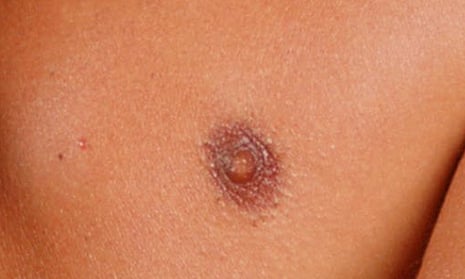An Instagram account depicting nipples in extreme closeup aims to topple sexist double standards in censorship on social media.
Genderless Nipples shares closeup images of nipples taken at such proximity, it is difficult – if not impossible – to tell whether they are male or female. After just 70 posts in six weeks, the account has close to 50,000 followers on Instagram.
Instagram is notoriously rigorous in removing images of women’s bare breasts, prompting the #FreeTheNipple campaign ongoing since 2012.
The @genderless_nipples project, created by three advertising students who met in New York, is taking a subversive approach in its bid to have the standards amended. Its bio calls for Instagram to “support ALL genders”: “Men are allowed to show their nipples, women’s get banned ... Let’s change this policy!”
This article includes content provided by Instagram. We ask for your permission before anything is loaded, as they may be using cookies and other technologies. To view this content, click 'Allow and continue'.
The project was started by Evelyne Wyss, 24, Morgan-Lee Wagner, 22, and Marco Russo, 28, to show the shortcomings of Instagram’s community guidelines.
Wyss told the Guardian she and her fellow advertising students had been inspired to act by the “horrible” discussion of women’s rights and gender equality during the US election period.
She said people should be treated equally on social networks, and questioned how Instagram could tell the difference between men’s nipples and women’s.
In December, their post showing what was in fact a male nipple was removed after having been found to have violated Instagram’s community standards.
“Instagram, you can’t even tell the difference between male and female nipples; who could? So why even bother banning female nipples if they can be so similar?” posted the account.
This article includes content provided by Instagram. We ask for your permission before anything is loaded, as they may be using cookies and other technologies. To view this content, click 'Allow and continue'.
Instagram’s guidelines prohibit images that show nudity, even those “that are artistic or creative in nature”, mostly to ease and ensure uniformity in the review process.
Photos that show sexual intercourse, genitals, or close-ups of fully-nude buttocks are removed. Those of female breasts showing the nipple are also restricted.
Photos of women breastfeeding or of breasts with post-mastectomy scarring are allowed, as are photos of nude figures in paintings, sculptures, and other art.
An Instagram spokesperson said in a statement that the platform was committed to allowing people to express themselves, “but we need to be mindful that our community is made up of people of different ages, backgrounds and beliefs.
“This is a complex area and it’s not always easy to satisfy everyone, but we are trying our best and we are listening to the community.”
Genderless Nipples requests “nipple donations” from Instagram users aged over 18 to post anonymously. It is reportedly receiving about 90 submissions a day.
The account’s administrators ask for sharp, well-lit photos, taken from a “Coke can” distance, of nipples that are hairless and hard – “to make it extra difficult for Instagram”.
This article includes content provided by Instagram. We ask for your permission before anything is loaded, as they may be using cookies and other technologies. To view this content, click 'Allow and continue'.
“We’re not against the rules, but we think they should be applied to all genders equally,” said Wyss. “Society is changing. We want to show Instagram that their policy is not working in today’s society any more.”
Wyss said she had “sadly” not had any response from Instagram. “We want to start an open dialogue with them. No fighting, just open and honest.”

Comments (…)
Sign in or create your Guardian account to join the discussion